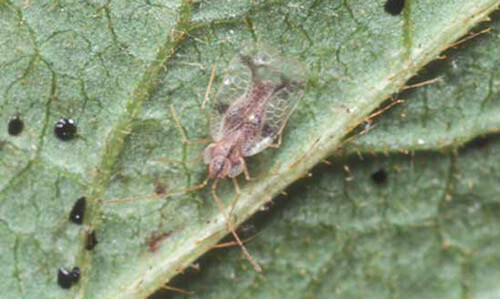
Lace bugs are a persistent problem in our mild climate. Photo: James L. Castner, University of Florida.
Lace bugs are a problem pest in the Pacific Northwest. Our mild climate means cold weather is unlikely to kill off lace bug in any of its life stages.
We wrote about lace bugs last summer. At the time we said you could reduce the problem by taking action in the spring.
There are things you can do now to manage lace bugs before it gets hotter and drier. The problem may get worse as heat and drought cause stress to susceptible plants.
How to tell if you have lace bugs
When lace bugs feed, they cause yellow pinpoints in the leaves. Heavily damaged leaves appear yellow. Lace bugs suck the life out of leaf tissue and may eventually kill your shrubs.
Lace bugs are about 1/8 inch long. They have clear wings sporting dark blotches in a lacy pattern. Eggs appear as black or brown dots on the underside of leaves. Nymphs look like tiny clear, yellow or black spiky things. Females lay eggs partly into the plant tissue, hidden under poop. This makes it tough to treat lace bugs with pesticides.
There are several types of lace bugs. All of them are specific to certain host plants. An article on lace bugs in City Living Seattle listed the following species: azalea lace bug (Stephanitis pyrioides), rhododendron lacebug (Stephanitis rhododendri), andromeda lace bug (Stephanitis takeayi), hawthorn lace bug (Corythucha cydoniae), grass lace bug (Leptodictya plana) and avocado lace bug (Pseudacysta perseae). Other types of lace bugs feed on alder, ash, coyote brush, birch, ceanothus, photinia, poplar, sycamore and willow.
What to do
Plant resistant varieties
Perhaps you have a plant that has been infested with lace bugs for the last few years. How much work do you want to do to manage the problem? You may choose to replace the plant with something that takes less work to look good and stay healthy. Spring is a good time to plant a new variety.
Resistant plants
Resistant Encore azalea cultivars include ‘Autumn Amethyst’, ‘Autumn Twist’, ‘Autumn Royalty’, ‘Autumn Sangria’, ‘Autumn Cheer’, and ‘Autumn Rouge’. Among evergreen azaleas, the cultivar ‘Micrantha’ shows some resistance. Deciduous azaleas with the most resistance are Rhododendron canescens and R. periymenoides.
You can also find a list of resistant azaleas here.
Resistant pieris varieties include Pieris phillyreifolia and P. japonica ‘Variegata.’
If you would prefer another type of shade-tolerant flowering shrub, try native Oregon grape, red flowering currant or exotic kalmia, hydrangea, osmanthus or daphne.
Mulch your landscape beds
Apply mulch or compost to beds in fall or spring when soil is moist and cool. Mulch keeps moisture in the soil and prevents shrubs from drying out. Remember to keep a 6-8 inch space between mulch and the plant stem.
Encourage beneficial insects
A number of insects eat lace bugs. This include spiders, green lacewings, earwigs, lady beetles, soldier beetles, assassin bugs, pirate bugs, plant bugs, tree crickets and mites. Research has shown that releasing lacewings among target plants reduces damage from lace bugs.
You can attract green lacewings and other beneficial insects by planting low-growing plants such as ornamental grasses, heather, salal, epimedium and other evergreen perennials. Flowering plants like dill, dandelion, fennel, cosmos and yarrow also attract beneficial insects. Maintain a wild area in your garden for a natural habitat that will protect and grow populations of beneficial insects.
Look for and destroy eggs and nymphs in spring
You could use a nontoxic spray such as horticultural oil, insecticidal soap and neem-based products. Coat the leaves well, including on the underside. Repeat regularly. We don’t recommend chemical insecticides. They kill important pollinators and beneficial insects that kill other pests.
Contact us if you would like help controlling lace bugs. We use M-Pede oil to reduce populations. It is made from a fatty acid. It’s safe and has limited effects on beneficial insects. We start monitoring for lace bugs in our clients’ landscapes in spring because nymphs are easier to kill than adults.
Manage water and fertilizer
As the weather gets hotter and drier, keep your plants well watered and don’t over-fertilize. Stressed plants (e.g., from too much sun) are more likely to be damaged by lace bugs. Most rhododendrons and azaleas prefer partial shade. A healthy plant will better resist insect damage.
References
Understanding the lace bug invasion, City Living Seattle.
Pests of Landscape Trees and Shrubs, an Integrated Pest Management Guide. 1994. UC Publication 3359.
Azalea Lace Bug: Biology and management in commercial nurseries and landscapes, Oregon State University.
Azalea lace bug, Oregon Metro.
Bugs & blights: lace bugs, Sharon Collman, WSU Cooperative Snohomish County Extension.
